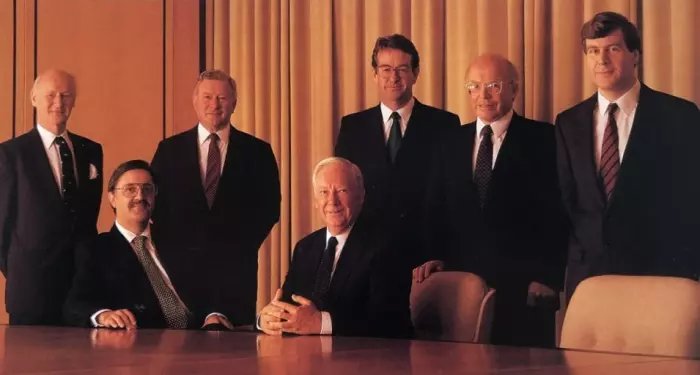The dismissal of Ron Brierley and Rob Campbell from the Bank of New Zealand (BNZ) board in early 1989 didn’t resolve the bank’s deep-rooted problems.
Following their removal, the board consisted of chairman Frank Pearson, deputy chair Susan Lojkine, Len Bayliss, Peter Leeming, Pat Morrison and David Sadler.
The board now faced two major challenges:
- Finance minister David Caygill remained keen to sell the bank and achieve the government’s $2000 million asset sales target.
- The company was due to report its result for the year to March 31, 1989 and needed to crystalise its bad-loans position by then.
National Australia Bank (NAB)
In early Feb 1989, NAB reaffirmed its interest in the BNZ and made a new indicative offer of $1100 million cash for 100% of the bank. This represented $927m for the crown’s 84.3% stake.
At the end of the previous year, NAB and Brierley Investments had been the only serious bidders, with NAB unwilling to make a firm bid, and Brierley offering $1011m for the crown’s shareholding. This sales process was aborted by the Lange government in Dec 1988.
Even though the latest NAB offer was lower than the Brierley proposal, Caygill was eager to keep NAB interested.
However, NAB wanted to undertake six weeks of due diligence and had two additional conditions:
- A portfolio of non-performing loans would be identified during the due diligence examination and the crown would be responsible for any losses for a three-year period up to a maximum of $400m.
- The government would protect NAB against most of the $230m of potential losses from the BNZ’s exposure to Rada Corporation.
However, BNZ didn’t want to go through a disruptive due diligence process unless it was fairly certain that a sale would result, while Caygill wanted a firm, unconditional offer of at least $1000m for the Crown shareholding before he would commit BNZ to due diligence.
The impasse couldn’t be resolved and on March 13, 1989, the cabinet decided it wouldn’t accept NAB’s conditional offer.
NAB’s second bite at the BNZ apple had failed, but it would be back again in three years to gobble up the bank after its rotten parts had been extracted.
Frank Pearson
Pearson, who was now in a very hot seat, wasn’t a professional director. He had a full-time position as investment manager at Colonial Mutual Life (CML).
An Englishman, he had worked in the finance sector in the City of London before emigrating to New Zealand in 1975. He quickly worked his way up the New Zealand corporate ladder and was investment manager at Government Life from 1980 to 1987.
He had a brief and unhappy stint at investment firm Fay, Richwhite in 1987 before joining CML in 1988.
In March 1989, he was chairman of a bank that had massive problems but neither he nor any member of the board had any experience in this area. They knew the general nature of the problems but couldn’t measure the extent of the crisis.
The bank had just over two months before it was to report its results for the March 31 year and before that, the board had to determine the extent of the loan losses and develop a plan to address any capital requirements.
Lindsay Pyne
Shortly after Pearson was appointed BNZ chairman on Feb 20, he approached Lindsay Pyne regarding the bank’s CEO position.
Pyne, who was 39 at the time, had started his career with the National Bank of New Zealand before going overseas and working for Hill Samuel, the British merchant bank, and Citicorp. He returned to New Zealand in July 1986 as managing director of Broadbank Corporation and was appointed CEO of PostBank in 1987.
A change at the top of the BNZ was badly needed because its aggressive corporate lending strategy had been a disaster. It needed someone with deep sector experience who would take decisive action. Pyne was the ideal man as he was reputed to be a tough banker and was open to Pearson’s offer after the government sold PostBank to ANZ Bank.
On March 16, just three days after the government had rejected NAB’s conditional offer for BNZ, Pearson announced that Pyne would become CEO from May 1, replacing the incumbent, Rob McCay, who would retire early.
McCay wasn’t the only one leaving the bank; Pyne initiated a massive cost-cutting exercise that resulted in a 40% reduction in staff numbers over the next four years. BNZ branch numbers declined from 401 in 1988 to 312 in 1992.
| BNZ – Staff & salaries | |||
|---|---|---|---|
Year | Staff numbers | Salaries ($m) | Average salary |
1983/84 | 7550 | 111.1 | $14,700 |
1984/85 | 7773 | 127.0 | $16,300 |
1985/86 | 8771 | 163.0 | $18,600 |
1986/87 | 9522 | 224.2 | $23,500 |
1987/88 | 10,067 | 283.2 | $28,100 |
1988/89 | 9006 | 299.2 | $33,200 |
1989/90 | 7739 | 285.7 | $36,900 |
1990/91 | 6354 | 251.2 | $39,500 |
1991/92 | 6020 | 249.8 | $41,500 |
March 31 years
Rural Bank
A major conflict developed between Pearson and the government in April 1989 over the sale of the Rural Bank by the Crown.
The BNZ board wanted to buy the Rural Bank but the Treasury and Caygill rejected this. Pearson was furious because it made a mockery of the idea that an independent board of directors – rather than government ministers and Treasury mandarins – was responsible for the BNZ, which was listed on the NZX and had 33,000 shareholders.
Fletcher Challenge bought the Rural Bank for $550m in 1989. It was onsold to the National Bank of New Zealand in Dec 1992.
Pearson believed that the acquisition of the former crown-owned bank would have strengthened the troubled BNZ, and his relationship with the Treasury, which was fragile at the best of times, deteriorated further.
Bad-debt provisioning
In April 1989, the BNZ board appointed Booz Allen Hamilton to undertake a review of the bank’s loan portfolio.
Thirteen senior staff from the US consulting firm analysed 77% of the bank’s loan portfolio over a four-week period and presented their findings to the bank’s monthly board meeting on May 25.
The situation was far worse than expected. Booz Allen identified loan losses well in excess of $1 billion for the March 1989 year. This was substantially above the following estimated figures:
- The $400m-plus provisioning assessed by Brierley Investments and NAB during the 1988 sales process.
- The forecast of $370m to $380m announced by Campbell on Jan 26, 1989, when he was acting chairman. This comprised a provision of $188m for the first half of the March ’89 year and the board’s anticipation of a similar amount for the second half.
- Pearson’s announcement on Feb 23 of a provisioning of $480m for the first 10 and a half months of the year, with more to come when the last six weeks of the year had been assessed.
The Booz Allen assessment created considerable problems for the BNZ because the government’s unwillingness to contribute new equity meant that the bank would fall below the Reserve Bank’s Tier 1 minimum capital ratio requirement of 4%.
The bank was attracting huge media attention, with the May 23 edition of the Auckland Sun – under the bold headline “BNZ loss may far exceed its forecast” – predicting “the BNZ’s bad debt provision could be as high as $780m, far more than the BNZ spoke of in February”.
Investors were also nervous, reflected in the bank’s share price falling from $1.40 to $1 since the end of 1988.
June 6 announcement
Hectic negotiations were held in Wellington over Queen’s Birthday weekend 1989 between the government, Reserve Bank, Bank of New Zealand and an external investor.
At 1.30pm on Tuesday, June 6, the BNZ released its March 1989 year result to the NZX and, simultaneously, prime minister David Lange and Caygill held a well-attended press conference.
The message was that the BNZ had recorded a $1294m provision for doubtful debts and reported a pre-tax loss of $946m for the year. This loss was reduced to an after-tax loss of $634m by a non-cash tax credit of $312m.
The BNZ also announced it would raise just over $400m of new equity through the issue of seven new shares for every 10 existing shares at $0.70 each. This was needed to meet its Tier 1 capital requirements.
Caygill revealed that Michael Fay’s Capital Markets, which the finance minister called a significant New Zealand public company, would assume liability for $300m of the $400m cash issue and Fay would join the BNZ board.
The news media, particularly television, went easy on the story because it coincided with the sensational footage of the Tiananmen Square massacre, particularly the indelible image of the man who stood defiantly in front of four Chinese army tanks.
Local media believed that the BNZ had been saved, rescued by Capital Markets, Michael Fay and their huge financial expertise.
But – and it was a big but – Capital Markets had only one employee and Fay had been out of the business loop while attempting to win the America’s Cup.
Looking back: David Lange, Roger Douglas, Ron Brierley and the BNZ
Looking back: BNZ Part 2: Rob Campbell, Frank Pearson and the bank
Disclosure of interests: Brian Gaynor is a non-executive director of Content Limited, the publisher of BusinessDesk, and of Milford Asset Management.
[email protected]
The original version of this article referred to Fletcher Building as having bought the Rural Bank. This has been corrected to refer to Fletcher Challenge.














